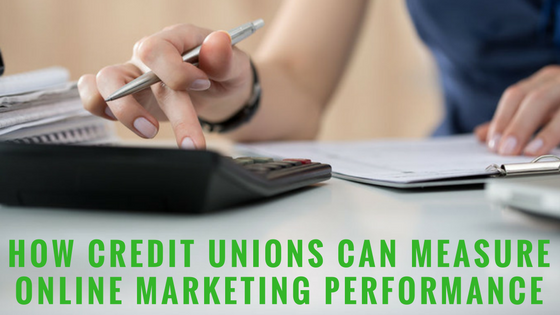
One challenge we regularly hear from credit union marketers is how to measure digital marketing performance. In fact, it was the highest-ranked pain point in our credit union marketing survey. Heavy workload, lofty goals, low budgets, small staff, and limited digital experience exacerbate this challenge.
Each year, the marketing budget gets more and more detailed – to the point where many marketers are expected to outline exactly how much output can be expected from each dollar spent.
With a higher degree of accountability and scrutiny, there’s a lower likelihood to move away from the more familiar marketing channels. As a result, so many credit union marketers have been slow or reluctant to embrace digital marketing channels.
Establishing a Credit Union Digital Marketing Measurement System
Measuring digital marketing performance starts with the right measurement system. The standard for website tracking is Google Analytics. It's free to use, and it’s constantly updated with new data and features to keep even the most experienced digital marketers happy.
Google Analytics should be able to track your website visitors through all of their actions on your website. This gets a little tricky since LOS providers have different rules regarding installing Google Tag Manager (and putting Google Tag Manager on the LOS is the best way to capture data with Google Analytics). We talk about this in more detail in this article.
When you get Google Tag Manager installed on the LOS, you should be able to track the following journey: a user clicks an online advertisement, views your current loan rates, and completes an online application; you can then associate that loan application with the ad campaign they came from. Armed with that data, you can truly assess the success of the loan campaign.
Calculate Cost-Per-Application (CPA) Results
Most credit union marketing campaigns are product-focused, so we want to track the number of new applications (checking account, Visa, auto loan, mortgage, etc.) generated from the campaign.
CPA is also referred to as the cost per acquisition by many digital marketers. Oftentimes, the acquisition being made is a member or loan application, but make sure you understand what you are counting as an "acquisition".
A real-life example of a cost per application would be if a mortgage campaign costs $6,000 and generates 20 completed applications, the resulting CPA is $300.
Related: What is a Good Marketing ROI?
We recognize there are real challenges with this methodology. For one, credit union campaigns don’t always have a single action that signifies success. It’s not always about getting the application. Multi-channel attribution also complicates things. If possible, your marketing team could combine your digital campaign reporting with your offline reporting to arrive at a more comprehensive CPA.
Establish a Performance Benchmark
Benchmarks are easy to understand and easy to apply. Before any marketing activity is started, everyone can expect campaign performance based on the benchmark. Also, as long as the right tracking mechanisms are in place, everyone can quickly determine if a campaign was successful or not.
Throughout the years of working with credit unions, we’ve run different types of campaigns in different markets with different types of segmentation and targeting. Thus, we have been able to establish some basic performance benchmarking.
Below are average credit union digital campaign CPA benchmarks based on our experience:
- General membership: average $125 cost per application
- Checking account applications: average $135 cost per application
- Auto loan applications: average $130 cost per application
- Credit card applications: average $135 cost per application
- Mortgage applications: average $350 cost per application (varies widely based on the market)
- Mortgage refi applications: average $350 cost per application
- Home equity loan applications: average $360 cost per application
- Personal loan applications: average $60 cost per application
It's important to note that a variety of factors can influence these CPAs. Geography, population, brand awareness, and competition all influence the cost of a campaign. Additionally, the credit union's rates and offers are the biggest indicators of potential success.
What is Counted as a Marketing Cost?
When calculating your CPA, a marketing cost is any incremental cost incurred to execute that campaign. This includes:
- Paid search ad spend (pay-per-click)
- Display ad clicks
- Other digital media spend
- Content production costs
- Outside credit union marketing agency fees
Because full-time marketing personnel costs are fixed, they are NOT factored into this calculation.
How to Take Campaign Measurement to the Next Level
Recognizing that everything cannot always be tied back to an online application, consider other key actions to include in campaign measurement.
For example, online “contact us” inquiries could be measured. In other campaigns, tracking the number of times users got directions to a branch could be a measure.
The point here is to make sure you’re tracking meaningful actions online and optimizing your campaigns over time to get as many of those actions as possible.
Final Thoughts about Measuring Online Marketing Performance
Just because a marketing activity can’t be measured perfectly doesn’t mean it shouldn’t be considered. That being said, marketers should always work to connect the dots between digital marketing activity and revenue. Advances in web analytics software and methodology provide better insight for measuring activity over time and across different devices.
Finally, marketing is about generating revenue. Marketers who aren’t serious about running efficient and profitable campaigns are missing the point. Implementing reporting based on a cost-per-action and treating it as the “golden metric” for digital marketing activity will focus the team on the ultimate outcome: growing the business.
You may also be interested in: Credit Union Marketing Resources






Agree, disagree, or just have something to add?
Leave a comment below.